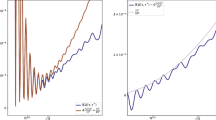Abstract
Adopting the standard mathematical framework for describing reduced dynamics, we derive two formal identities for the density operator of an open quantum system. Each of these is equivalent to the old Nakajima-Zwanzig equation. The first identity is local in time. It contains the inverse of the dynamical map which govern the evolution of the density operator. We indicate a time interval on which this inverse exists. The second identity constitutes a suitable starting point for going beyond the Markov approximation in a controlled way. On the basis of the Bloch equations we argue once more that in studying quantum dissipation one has to pay attention to the von Neumann conditions. In the Nakajima-Zwanzig equation we make the first Born approximation. The ensuing master equation possesses the correct weak-coupling limit. While proving this rather obvious but at the same time important statement, we elucidate the mathematical methods which underlie the weak-coupling limit. Moving to a two-dimensional Hilbert space, we find that both for short and for long times our approximate master equation respects the von Neumann conditions. Assuming exponential decay for correlation functions, we propose a physical limit in which the solutions for the density operator become Markovian in character. We confirm the well-known statement that, as seen from a macroscopic standpoint, the system starts from an effective initial condition. The approach to equilibrium is exponential. The accessory relaxation constants can differ from the usual Bloch parameters γ⊥ and γ∥ by more than 50%.
Similar content being viewed by others
References
L. I. Schiff,Quantum Mechanics, 3rd ed. (McGraw-Hill, New York, 1968), p. 379.
P. Roman,Advanced Quantum Theory (Addison-Wesley, Reading, Massachusetts, 1965), p. 93.
W. H. Louisell,Quantum Statistical Properties of Radiation (Wiley, New York, 1973), p. 76.
V. Gorini, A. Frigerio, M. Verri, A. Kossakowski, and E. C. G. Sudarshan,Rep. Math. Phys. 13:149 (1978).
E. B. Davies,Quantum Theory of Open Systems (Academic Press, London, 1976), p. 154.
S. Haroche, inLes Houches Lecture Notes, Session XXXVIII, G. Grynberg and R. Stora, eds. (North-Holland, Amsterdam, 1984), p. 193; S. M. Barnett and P. L. Knight,Opt. Acta 31:435 (1984); H. Walther,Phys. Scripta T 23:165 (1988).
P. L. Knight and P. W. Milonni,Phys. Lett. 56A:275 (1976), and references therein; K. Wódkiewicz and J. H. Eberly,Ann. Phys. (NY)101:574 (1976).
E. B. Davies,J. Math. Phys. 15:2036 (1974).
R. Alicki and K. Lendi, inLecture Notes in Physics, Vol. 286, W. Beiglböck, ed. (Springer, Berlin, 1987).
V. Gorini, M. Verri, and A. Frigerio,Physica A 161:357 (1989).
R. Alicki,Phys. Rev. A 40:4077 (1989).
G. Dattoli, J. Gallardo, and A. Torre,J. Math. Phys. 27:772 (1986).
F. Haake,Z. Phys. 223:353 (1969).
E. B. Davies,One-Parameter Semigroups (Academic Press, London, 1980).
H. Grabert, P. Talkner, and P. Hänggi,Z. Phys. B 26:289 (1977).
N. Hashitsume, F. Shibata, and M. Shingū,J. Stat. Phys. 17:155 (1977).
F. Haake, inSpringer Tracts in Modern Physics, Vol. 66, G. Höhler, ed. (Springer, Berlin, 1973), p. 98.
L. van Hove,Physica 21:517 (1955).
E. B. Davies,Commun. Math. Phys. 33:171 (1973);Commun. Math. Phys. 39:91 (1974);Math. Ann. 219:147 (1976).
V. Gorini, A. Kossakowski, and E. C. G. Sudarshan,J. Math. Phys. 17:821 (1976).
G. Lindblad,Commun. Math. Phys. 48:119 (1976).
K. Hepp and E. H. Lieb,Helv. Phys. Acta 46:573 (1973).
A. Abragam,The Principles of Nuclear Magnetism (Oxford University Press, Oxford, 1961).
L. Allen and J. H. Eberly,Optical Resonance and Two-Level Atoms (Wiley, New York, 1975).
R. Loudon,The Quantum Theory of Light (Oxford University Press, Oxford, 1973).
J. V. Pulè,Commun. Math. Phys. 38:241 (1974); G. G. Emch and J. C. Varilly,Lett. Math. Phys. 3:113 (1979).
J. Budimir and J. L. Skinner,J. Stat. Phys. 49:1029 (1987); B. B. Laird, J. Budimir, and J. L. Skinner,J. Chem. Phys. 94:4391 (1991); B. B. Laird and J. L. Skinner,J. Chem. Phys. 94:4405 (1991).
G. S. Agarwal, inProgress in Optics, Vol. XI, E. Wolf, ed. (North-Holland, Amsterdam, 1973), p. 1.
M. Reed and B. Simon,Methods of Modern Mathematical Physics, Vol. I (Academic Press, New York, 1972), p. 209.
T. Kato, inDie Grundlehren der mathematischen Wissenschaften, Vol. 132, B. Eckmann and B. L. van der Waerden, eds. (Springer, New York, 1966), p. 146.
E. B. Davies and H. Spohn,J. Stat. Phys. 19:511 (1978).
A. Fuliński and W. J. Kramarczyk,Physica 39:575 (1968).
V. P. Vstovsky,Phys. Lett. 44A:283 (1973).
P. R. Halmos,Finite-Dimensional Vector Spaces (Springer, New York, 1974), Chapter IV.
H. Spohn and J. L. Lebowitz, inAdvances in Chemical Physics, Vol. 38, S. A. Rice, ed. (Wiley, New York, 1978), p. 109.
A. Suárez, R. Silbey, and I. Oppenheim,J. Chem. Phys. 97:5101 (1992).
M. Reed and B. Simon,Methods of Modern Mathematical Physics, Vol. II (Academic, New York, 1975), p. 13.
K. Lendi and M. Rothier do Amaral Jr.,Rev. Brasil. Fisica 13:294 (1983).
T. A. Burton, inMathematics in Science and Engineering, Vol. 167, R. Bellman, ed. (Academic Press, New York, 1983), Section 4.2.
M. Abramowitz and I. A. Stegun, eds.Handbook of Mathematical Functions (Dover, New York, 1965), p. 17.
Author information
Authors and Affiliations
Rights and permissions
About this article
Cite this article
van Wonderen, A.J., Lendi, K. Quantum theory of dissipative processes: The Markov approximation revisited. J Stat Phys 80, 273–305 (1995). https://doi.org/10.1007/BF02178360
Received:
Accepted:
Issue Date:
DOI: https://doi.org/10.1007/BF02178360




